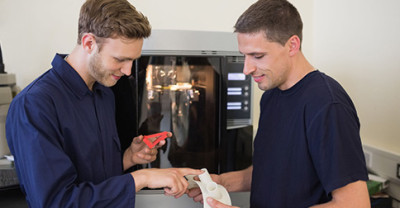
3D printing has become a game-changing tool not only for industry, but for education as well.
The number of programs across the nation that have adopted 3D printing has increased over the past few years. These days, you don’t have to go very far to find a school that features 3D printing in its curriculum.
What’s best is when 3D printing creates new opportunities for programs that seek to expand horizons for students with limited economic resources.
That is the case with Berea College, a small liberal arts work college just south of Lexington, Kentucky. Berea College caters to students in Appalachia and the Rust Belt that may not be able to afford higher education on their own, primarily by offering a unique no-tuition promise.
One professor, Brad Christensen, chose to use 3D printing to instruct his students in the science of engineering and give them opportunities that they wouldn’t have had otherwise – all using a Stratasys 3D printer.
Designing, Building, and Printing
As a professor of Technology and Industrial Arts at Berea, Christensen teaches a Technology I class that introduces students to technology.
One project he gives his students revolves around creating parts for radio-controlled boats. Most of his students, according to Christensen, “have never designed anything. Many have never measured or cut on a line before. This is their first exposure to the engineering process, their first try at making something work.”
The initial task was to design a propeller for a radio-controlled boat. Normally, that is a simple task, but for students who had never attempted engineering before, it was a challenging and rewarding project. The students used technology to design their propellers and draw them on a computer in 20 minutes, getting the propeller the way they wanted it so they could then send it to a Stratasys 3D printer – in this case, a Dimension BST purchased with grant money.
The Dimension series uses Fused Deposition Modeling (FDM) which involves a plastic filament that is fed into an extrusion head and then heated into a semi-liquid state. Then, it is used to form the part, layer by layer.
After printing the piece, students could test it, revise their design, and print another. A part such as this from a hobby store could cost $35, but the Dimension printer brought the cost down to $10 per completed part – savings that made the project possible.
Plus, 3D printing prevented the students from having to fabricate from metal, which wouldn’t have allowed them the precision and prototyping abilities that 3D printing affords.
Students ultimately took their designs to a nearby pond and tested them on radio-controlled boats to see how well they worked. They were able to see their designs and work turn into a real, practical result.
Bridging the Gap with 3D Printing
There is a growing gap between skilled workers currently in the workforce and their replacements — younger workers who will have to step up as these older workers retire.
Technology like 3D printing could help bridge that gap by encouraging younger students to move into skilled trades and professions. In fact, out of the 44 students in Christensen’s class, over 20 said these projects encouraged them to pursue a degree in engineering technology.
Said Christensen, “The 3D printer adds a new level to what we teach. It is a new avenue for learning. The printer has added a lot to my class.”
